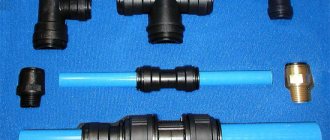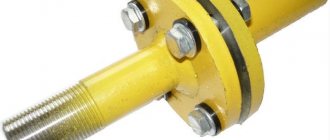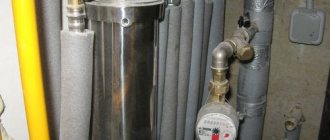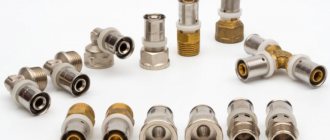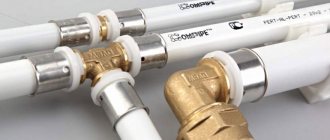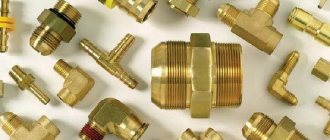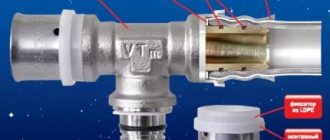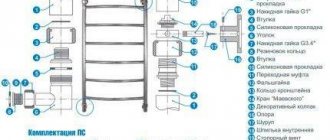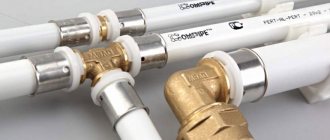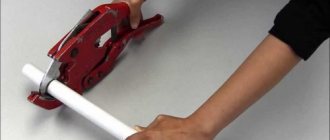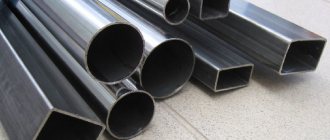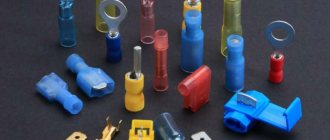Andrey
7537 0 0
Andrey July 31, 2016Specialization: facade finishing, interior finishing, construction of dachas, garages. Experience of an amateur gardener and gardener. We also have experience in repairing cars and motorcycles. Hobbies: playing the guitar and many other things that I don’t have time for :)
Often people who independently undertake the renovation of an apartment or house wonder about assembling pipelines from metal-plastic pipes. In reality, there is nothing complicated about this, however, like any other work, the installation of metal-plastic pipes contains its own nuances and subtleties. Therefore, below I will tell you in detail about all the methods for assembling a pipeline from “metal-plastic”.
Pipeline made of metal-plastic pipes
Video
In this video, a specialist will share his knowledge and tell you how to install a home heating system with your own hands:
Today, water supply is produced using modern materials.
Metal-plastic pipelines have become a very popular option for using these products for cold and hot water supply, as well as heating. However, it is worth knowing that when installing metal-plastic pipes with your own hands, it will be appropriate to additionally install gearboxes. This type of pipe does not like pressure drops in the system; reducers equalize this pressure.
Water pipe routing diagram.
Fasteners and other materials
In addition to the pipes themselves, for installation you need to prepare in advance:
- Fastening materials:
- plastic fastening clips or clamps for polypropylene pipes of a given diameter;
- dowel-nails.
- Tools:
- hammer;
- drill;
- crosshead screwdriver;
- scissors or a knife for cutting pipes;
- roulette;
- level;
- marker.
Clips - their meaning and installation details
The clip is made from a special material - nylon. It has such useful properties as high heat resistance and resistance to mechanical stress.
Among the technical characteristics of the clip, you need to pay attention to the diameter; it must correspond to the size of the outer diameter of the polypropylene pipe. Installation of clips has its own rules, the implementation of which determines the service life of the finished communication system
Single clips and double clip
The main issue that is important not to miss is the step size between the clips. If you install the clips too far apart, there is a risk of sagging in the support areas
When installing a communication system with two parallel pipes, use a double clip.
Correct pitch between clips
In what cases are clamps used?
It is recommended to fasten polypropylene pipes to the wall using clamps in cases where it is necessary to install large-diameter pipes with a fairly heavy weight. The clamps are a design with a screw tie and a rubber internal gasket, which is necessary to compensate for vibration. Thanks to this, they reliably hold the pipe even when strong vibrations occur.
The clamps are equipped with a dowel and a pin. The mount can be made of metal or plastic. When laying polypropylene pipes, it is better to choose clamps from similar raw materials: this way you will ensure the same strength indicators for the entire structure. Installation of fastening material can be rigid or floating:
- Rigid fastening is made by tightening the clamp extremely tightly around the pipes. A rigid coupling is required in areas below the bell. Thanks to rigid fixation, the possibility of displacement of the communication system is eliminated.
- A floating mount indicates that there is a gap between the pipes and the clamp. The fastening is tightened in such a way as to allow free movement of the pipe. The mobility of the fasteners allows the pipes to expand during temperature changes.
How to attach the clamp
Bending of metal-plastic pipes
I will outline how to bend metal-plastic pipes without any equipment, in other words, by hand.
We determine the place where the pipe bend should be.
We clasp the pipe from above with our palms in this place so that the huge fingers are placed along the pipe and towards each other, with their tips touching (or almost touching). The other fingers simply hold the pipe, wrapping it around it.
By applying a little force we bend the pipe a little (!). In all this, the huge fingers play the role of a kind of support.
We move our palms slightly away from each other, the position of the fingers does not change at all (in the sense, the huge fingers are placed along the pipe and towards each other, just at a slightly greater distance).
Again we apply a little effort, adding a twist. Again we move our hands away from each other, add a twist with a little effort... and so on until we get a metal-plastic pipe with a twist of the required radius.
As I already said, you need to practice on scraps of metal-plastic pipe, and only later use the skill in the finishing work of installing a water pipeline.
Shredding brick walls with a hammer drill
A hammer drill is a universal construction tool that can be used to drill holes and knock out hard materials - thanks to these properties, the tool can quite effectively knock out channels for water supply or heating pipes. The work order is as follows:
- Pobedit drill for concrete with a diameter of 8 or 10 mm. in perforation mode, it makes a series of holes of the required depth along the entire length of two lines, the step can be chosen arbitrarily, but the smaller the distance between the holes, the better the quality of the groove edges.
- Next, insert a shovel-shaped attachment into the hammer drill, switching it to impact mode, and knock the brick between the drilled grooves, controlling the depth with a pipe section.
- Upon completion of the work, the groove is cleaned of dust and foreign debris; for this you can use a household vacuum cleaner.
Rice. 8 Angle shifter with two discs
Pressure testing of the water supply system
When the installation of a water supply system made of metal-plastic pipes is completed, it is necessary to check it for leaks using the pressure testing process:
- It is necessary to shut off the test area filled with water to seal it (using taps/valves).
- Connect a pump to the connection pipe of one of the taps (a manual, low-power one is suitable for a home water supply system).
- Using a pressure testing pump, pump water into the selected area at a pressure greater than the calculated operating pressure, then turn off the pump and record the pressure gauge readings.
- Maintain the system under pressure for some time - at least half an hour.
- Then the current pressure gauge readings are compared with the original value. If the two values are different, something has gone wrong, there is a leak.
Pipe pressure testing pump
If you have an open gasket, the problem area can be detected visually. After eliminating the malfunction, you will have to re-pressure test.
Grilling technology using various construction tools
When deciding how to groove a wall in the bathroom for pipes or make channels in the floor to run hot heating pipelines through, they resort to dismantling work using the following methods and tools.
Hammer and chisel
An old-fashioned method, suitable for working on walls made of soft building materials (gas silicate blocks, foam concrete, gypsum plaster). During installation, at the beginning, special grooves are knocked out along two lines of the channel with a depth of about 10 mm, then the material is removed between the punched lines, after which the operation is repeated many times until the desired depth is obtained.
Hammer
To work with a hammer drill, a special construction attachment in the form of a spatula is used; the tool is used to break through any type of wall. The main disadvantage of the hammer drill is the not very aesthetic appearance of the punched channel and a large amount of excess debris - during operation, material is knocked out outside the outer perimeter of the groove.
Therefore, to optimize the work, before using a hammer drill, the boundaries of the grooves are cut with an angle grinder (grinder) or holes of the required depth are drilled into them in increments of about 10 mm.
Rice. 4 Chipping with a hammer and chisel
Bulgarian
When working with a grinder, special discs with diamond coating for concrete are used to cut through concrete or brick walls. The grinder is a dangerous tool, so it is imperative to use a protective cover on the body when working with it.
Using an angle grinder, smooth, deep lines are cut along the perimeter of the groove, after which the material between them is knocked out with a chisel or hammer drill.
The main disadvantage of working with an angle grinder is the high dust content in the air; for protection you should use dust goggles, thick clothing and a respirator.
Laying polypropylene pipes in the wall
Very often, water and sewer pipes that are located along the walls of a room simply spoil its appearance. Therefore, many are interested in how polypropylene pipes are laid in the wall
This must be done carefully and thoughtfully, taking into account all the possible consequences of such camouflage.
Is it possible to bury polypropylene pipes in walls?
These pipes are made of material that is resistant to chemicals and is not afraid of corrosion. Installation is carried out by welding, and the connection is permanent and monolithic. Under this condition, there is no need to constantly tighten the connection, which would have to be done with metal pipes. Therefore, installation of polypropylene pipes in the wall is possible, however, if the condition of the pipe type matching the coolant in terms of pressure and temperature is met. For hot water pipes, you need to leave the necessary space for its expansion.
Rules for hidden installation of pipes
1. The system hidden in the wall should be as seamless as possible and have as few connections as possible.
2. The connecting elements of the pipeline must be made of the same material as its main part and have the same or even greater safety margin.
3. All pipes walled into the wall must have thermal insulation. This prevents them from fogging. Also, such a measure will give the pipes free opportunity to expand and contract.
4. Before masking the pipes, do not forget to leave free access to the inspection, shut-off valves, etc. You can close the holes with special plumbing hatches, of which there are many on sale and their sizes vary.
The process of masking pipes into the wall
1. Embedding a polypropylene pipe into a wall involves cutting the wall. Let’s say right away that horizontal gating of panel walls is prohibited. This also applies to brick walls laid out in half brick, since this thickness is not sufficient for such work.
2. Make special recesses in the wall. These are the grooves. Sewage and water pipes will be removed there. To do this, use a grinder or a hammer drill.
3. Make markings with a pencil. Place a special disc for cutting stone on the grinder. For large-area work, it is wiser to buy a disc with diamond-tipped teeth.
4. Do one of two things. Use a grinder to follow two lines, cutting them to the required depth. Then use a chisel to knock out all the excess. You can also do this: cut two marked lines with a grinder and use a hammer drill to connect them into one. Here you need a special attachment in the form of a spatula.
5. There is a special attachment for working with a hammer drill. It is intended specifically for gating walls. Its purchase eliminates the need to mark the future channel.
6. Install polypropylene pipes into the grooves. If the hole in the wall is larger than the pipe, then it’s okay. The grooves for hot water pipes should already be wider than the pipe itself. After installing the pipes in the grooves, they are cemented, and the wall is plastered so that it is completely level.
What legal documents prohibit sewing up pipes?
Good afternoon, we are remodeling an apartment, we have received technical conditions for replacing the heating system and the cold water and sewerage systems, we have a permit and a design, the technical conditions state that access to utility networks must be provided.
We carried out the redevelopment, made inspection hatches, but received a refusal from the management company that the project was completed correctly, citing the fact that our pipes were sewn up, but we provided access, made inspection hatches to all communications, and the heating riser was also laid behind suspended ceiling, which they write about is not possible.
Give me links or some regulations that they refer to, we were referred only to the rules for the maintenance and operation of the housing stock
Vera, good afternoon. You must provide your management company with access to utility networks on the basis of Decree of the Government of the Russian Federation dated May 6, 2011 N 354 “On the provision of utility services to owners and users of premises in apartment buildings and residential buildings”
34. The consumer is obliged to: e) allow representatives of the contractor (including emergency services workers), representatives of state control and supervision bodies into the occupied residential or non-residential premises to inspect the technical and sanitary condition of the apartment equipment in advance agreed with the contractor in the manner specified in paragraph 85 of these Rules, time, but not more than once every 3 months, to check the elimination of deficiencies in the provision of public services and perform the necessary repair work - as necessary, and to eliminate accidents - at any time;
There is also SNiP
SP 30.13330.2012 Internal water supply and sewerage of buildings. Updated version of SNiP 2.04.01-85* 5.4.9 Water risers and cold and hot water inlets into apartments and other premises, as well as shut-off valves, measuring instruments, regulators should be placed in communication shafts with the installation of special technical cabinets that provide free access to him technical staff. The laying of risers and wiring may be provided in shafts, openly - along the walls of showers, kitchens and other similar premises, taking into account the placement of the necessary shut-off, regulating and measuring devices.
For premises with high finishing requirements, and for all networks with pipelines made of polymeric materials (except for pipelines in sanitary facilities), hidden installation should be provided. Hidden installation of steel pipelines connected with threads (with the exception of elbows for connecting wall-mounted water fittings) without access to the butt joints is not permitted.
Advantage of plastic pipes
- Plastic pipes, unlike metal ones, are not subject to corrosion and are therefore environmentally friendly. During operation they do not become clogged, do not hum or vibrate.
- Plastic is a dielectric and does not allow electric current to pass through - electrical safety. Thanks to this property, pipes can be used for laying cables.
- They can withstand high temperatures (up to 95 degrees) and do not heat up, which ensures low heat losses.
- Plastic pipes are many times lighter and more elastic than metal ones.
- Cost-effective, a water supply system assembled from polymer pipes is 15-20% cheaper than the same system made from metal pipes. The service life of such pipes is approximately 50 years.
Based on the above, we can draw the following conclusion: plastic pipes are an excellent alternative to steel and cast iron pipes; they are well suited for cold and hot water supply and heating systems.
Installing plastic pipes does not require such large equipment, and almost anyone can carry out the assembly. The main thing is to observe certain nuances and adhere to the sequence of actions so that the system lasts a long time and does not cause problems during operation.
To complete the work you will need:
- Roulette;
- Soft pencil or marker;
- Special pipe cutter;
- Stripping (if foil-reinforced pipes are used);
- Well, and most importantly, a soldering iron (welding machine) with attachments.
How to properly weld polypropylene pipes?
Now here is the most important point on how to properly weld polypropylene pipes. To begin with, set the required operating temperature on the welding machine, attach the nozzles of the required diameter, and turn it on to warm up. While the soldering iron is heating up, prepare the pipes and fittings.
- We measure and cut the pipe to the required length. When using reinforced pipes, they must be cleaned;
- Use alcohol to degrease the joints;
- We measure the depth of the fitting and transfer minus 2mm to the pipe;
- On the parts we mark the alignment for correct placement.
We have already discussed the more detailed process of soldering plastic pipes earlier.
The device has warmed up, and now we proceed directly to soldering:
- Taking the pipe and fitting in your hands, we simultaneously insert it into the nozzles, the pipe to the mark, and the fitting until it stops. We warm up for the required time, each diameter has its own time (usually the table is on the lid of the suitcase from the device).
- At the end of warming up, we remove the parts from the nozzles and smoothly connect them, aligning our marks for alignment.
- Fix the connection until it cools.
To achieve the best soldering result, it is strictly forbidden to rotate the parts during the soldering process.
Is it possible to hide polypropylene pipes in the wall?
Is it possible to hide plastic pipes in the wall? If you follow a number of recommendations, yes.
- The pipe should have as few connections as possible and be as solid as possible;
- All elements are made of the same material;
- Thermal insulation of pipes must be performed;
- Access to taps and meters must remain free.
How to install polypropylene pipes in the wall?
- First you need to make markings;
- Next, according to the markings, grooves are made;
- Connect the pipes and install them in a prepared place;
- Next comes the painting work.
How to cut a hole in a suspended ceiling for a pipe?
When installing suspended ceilings, it becomes necessary to bypass the pipes. How to cut a hole in a suspended ceiling for a pipe without damaging it. To do this, an incision is made on the working surface and reinforced with a special lining that will protect the ceiling from spreading.
It is better to make the overlay from 1-2mm. plastic. Cut out a rectangle 1.5 cm wider. on the diameter of the pipe. The length of the rectangle is equal to the distance from the baguette to the outer edge of the pipe, plus 1.5 cm. We draw a line in the center. On one side of the rectangle we draw a circle 4-6mm larger than the diameter of the pipe. At a distance of 3-5mm. We draw a semicircle from the circle, lower lines from it to the opposite edge, we get the outer part of the ring. Now we carefully cut everything out, the ring cover is ready.
The simplest way to bypass the pipe is to install a cover on the outside of the canvas. The entire canvas is tucked into a baguette, not reaching 20-25cm. to the pipe on both sides. Next, in the center of the pipe, the canvas is carefully cut and tucked into place. Now we put the ring cover on the pipe and glue it to the canvas. All is ready.
Materials and tools for installation
To carry out installation, you will need the following:
Installation of metal-plastic pipes.
- pipe cutter or hacksaw for metal with fine teeth; construction knife; hammer; external and internal mandrels; set of adjustable wrenches; fittings, nuts, ferrules, fastening clips; calibrator; pliers; drill; dowels, screws, nails (for fastening clips).
The advantages of metal-plastic pipes include:
- ease of installation; low price; ability to operate for a long time at high temperatures; mechanical strength; low coefficient of thermal expansion; long service life (50 years); absence of mineral deposits; corrosion resistance; aesthetic appeal.
Close the riser with a box
This is one of the two most popular solutions. Unsightly pipes are hidden in a box erected over a frame, and from this box an open line comes out to the heating radiator. The remaining open battery itself can be placed in a decorative perforated box.
Advantages of the box
- The riser pipes are no longer visible;
- The cheapest option for closing with a building structure;
- Does not require any permits or approvals.
Disadvantages of the box
- Having gotten rid of the riser pipes, we still left the supply pipes to the radiator open;
- The aesthetic appeal of the box is very questionable (in most cases, I’ll tell you about exceptions at the end of the publication);
- The hidden location of the riser makes it difficult to detect leaks and eliminate them. Even if an inspection hatch is installed in the box, dismantling the structure may be required to carry out repair work.
Features of polymer products
As you know even from a school physics course, when substances are heated, they begin to increase in volume. This is directly related to plastic products, and the high temperature also makes them plastic.
When installing pipelines for cold water, you can not take into account the expansion coefficient (for more details: “Preliminary calculation of the thermal expansion of polypropylene pipes”). At the same time, when arranging the heating structure, this nuance must be taken into account.
It is this circumstance that raises doubts among many home craftsmen as to whether it is possible to wall up polypropylene pipes into the wall, which will begin to lengthen and expand when the hot pipeline is started.
This raises a logical question as to whether the finishing materials in which the elements of the engineering system are embedded will be damaged.
Experts assure that metal pipe products that expand slightly can simply be embedded in a layer of material, but in order to hide polypropylene pipes in the wall, you have to fully adhere to the technology of installation work (more details: “Types, properties, installation of propylene pipes with your own hands”) . Otherwise, the finishing of the room will become covered with cracks, and the tile covering will most likely fall off.
When a hidden heating system is unacceptable for safety reasons
Safety regulations contain provisions that access to communications must be ensured without interference. It follows from this that pipe joints cannot be tightly walled up; therefore, it is only permissible to close the area in which the probability of leakage is zero.
Do not use metal pipes for laying in the wall, as they are susceptible to corrosion
The competence of regulatory authorities includes assessing the thickness of the wall. So, if it is not enough, the permit will be denied.
Making walls for pipes with your own hands
After drawing up a plan for the placement of the pipeline, taking into account the fact that all branches and changes in direction in the line are carried out at right angles, begin marking. The work is performed in the following sequence:
- Checks for the presence of hidden wiring at the work site; if there is no layout diagram, you can use a special device to search for wires.
- Using a construction pencil and a level, two lines are drawn on the wall, corresponding to the width of the pipes with a small margin. If a heat insulator is used on a hot water pipeline, increase the width of the channel accordingly.
- Once you have finished marking the walls using a building level, tape measure and pencil, you can begin grooving; the above tools are used when carrying out the work.
If gating is necessary, there are several options for how to most effectively carry out this procedure; to carry out the work you can:
- Use the services of hired specialists; the cost of one linear meter of groove, depending on its parameters, wall material and region, fluctuates within 5 USD. per linear meter.
- If you don’t have the necessary tool, you can rent it and do the work yourself, saving some money.
- If you have your own hammer drill and the necessary attachments for it, you can drill the wall yourself using only this tool. If you only have a grinder, use it to cut through the wall, and you will have to knock out the material manually using a chisel and hammer.
Rice. 6 Cutting a channel using a grinder with a diamond blade
Hidden heating pipes
Pros and cons of hidden gasket
The undoubted advantage of this method is that there is no need to fear that when designing the room, the heating pipes will not fit harmoniously into the interior.
Disadvantages of hidden installation:
- Labor intensity.
- The presence of heat loss, since even with high-quality pipe insulation, part of the heat is spent on heating the structure, which simultaneously performs protective and decorative functions.
- Difficulty of maintenance associated with the need to dismantle protective and decorative structures to access emergency areas;
- High price due to the need for more material.
Hidden installation of heating pipes in the floor is carried out before pouring the screed
Hidden heating pipe technology
Installation of heating pipes is carried out after installing all radiators on the walls. During finishing work, the original packaging of radiators is not removed.
Stages of work production:
- Preparation, including choosing the type of heating. To install a forced circulation system, it is best to lay heating pipes under the floor or in a wall structure. With natural circulation, the discharge pipe is placed behind the suspended ceiling, and the riser drains and the lower pipeline are laid in the wall.
- Pipeline markings made on walls.
- Execution of grooves. First, using a grinder, its boundaries are set, then the groove itself is knocked out with a puncher.
Laying heating pipes in a groove
- Wiring laying. The heating pipes are secured in the groove using clips.
It must be remembered that the use of detachable connections, such as connections with detachable nuts, collet connections for metal-plastic pipes, is unacceptable for hidden wiring.
- Connecting the pipeline to heating devices.
- Crimping is carried out, in accordance with current standards, under pressure.
For hidden wiring, pipes must be filled only after a hydraulic test (pressure testing) of the heating system.
- Decorating or walling up. Before starting work, the pipes must be insulated. Decoration can be done in the following ways:
- Plastering - sealing the groove with a low-strength solution of sand and cement or gypsum-based plaster.
- Heating pipes in the wall can be decorated with plasterboard. Strips of drywall are glued using gypsum plaster. The subsequent putty completely masks the groove.
- Boxes made of plasterboard, which do not require damaging the walls. They are used quite often, since their use eliminates the need to destroy the finish when problems occur.
Decorating the heating pipeline with a box
The sealing of the pipeline should only be carried out when the entire heating system is under pressure, which emulates its “behavior”. Making the necessary adjustments allows us to achieve minimal impact of deformation forces on the decorative finish.
Preparation for installation
The primary task is to draw up an installation drawing of future highways. In fact, the pipeline plan must be carried out taking into account all connections, taps, technological cabinets, shut-off valves. Detailed planning helps to avoid redundant connections and waste of material, since it is determined in advance which parts and in what quantities are needed.
Walls for hidden installation of pipes will have to be grooved, that is, a channel will have to be cut in the concrete for laying a pipe line. It is advisable to pre-mark the working area in order to make an even and high-quality channel.
It is advisable to take into account that it is not recommended to groove walls in panel houses, since the thickness of the panels is usually small. The most suitable walls are made of thick brick or concrete. They can be tapped without fear.
Next, you need to mark the pipes and fittings to know the welding direction and installation order. If necessary, it is better to trim the products in advance.
To perform installation work, you need tools designed for polypropylene:
- cutting scissors;
- a shaver for removing reinforcement and a chamfer for leveling the cut surface;
- welding machine with temperatures up to 260 °C;
- wall chaser or grinder for cutting out a cavity in the wall;
- chisel and hammer or punch to remove material between the grooves.
Installation
When the tools are ready, there is a detailed plan for installing pipe lines and markings, you can start working:
- Using a grinder or wall chaser, cut parallel to each other slots on the concrete surface of the wall; the distance between the slots should be slightly greater than the thickness of the polypropylene pipe in the thermal insulation. It is recommended to use a stone disc or a toothed disc coated with diamond.
- Use a hammer drill or chisel to remove concrete between the slots.
- To place technological cabinets, you will have to make a cavity in the wall and install a cabinet with slots for communications in it. This design will facilitate access to shut-off valves or sensors.
- The pipes are welded in advance, after which they are laid in the wall and fixed in the channel with clamps or supports. It is advisable to do most of the welding outside the channel because it is easier than welding in a confined space. Before sealing the grooves, it is recommended to check the system for leaks by running water into it. If no leaks are observed, then you can proceed to the final finishing.
- Before laying the pipes, it is advisable to wrap them in a layer of energyflex, or fill them with polyurethane foam after installation. This will provide space for the pipe to expand.
Of course, you can lay pipes on top of the walls, and make finishing on top of the main line, but then the free space in the room is reduced, and the cavity formed between the finishing and the wall will have to be filled with insulation. This approach is ineffective, since the finishing material must adhere tightly to the surface.
If you need to hide a ready-made pipeline structure, it is better not to make a blank monolithic wall, but to build a special plasterboard box to ensure free access to the pipes if necessary.
After a test check of the functionality of the pipeline, you can begin finishing the wall; it is better to use drywall for this.
Installation requirements
When laying pipes in the wall, it is recommended to use shock-absorbing materials. For example, energyflex, polyurethane foam. These materials will serve as a gap between the wall and the pipe; accordingly, there will be no pressure on the concrete when the pipe expands.
We recommend that you read: Shut-off valve and its role in pipelines
The fewer connections, the better. Connections are the most vulnerable part of polypropylene systems, least protected from leaks and having low pressure resistance.
Pipes must be selected in accordance with the conditions of further operation.
Based on wall thickness, all PPR pipes are divided into categories from PN10 to PN25.
- PN10 pipes are thin-walled, designed for cold water supply or for heated floors and other low-temperature, low-pressure systems.
- PN16 and PN20 are used for water supply with pressure up to 1.5 MPa and heating systems with pressure not exceeding 0.8 MPa.
- PN25 is reinforced with a layer of fiberglass or aluminum, which increases strength and temperature range. Accordingly, the products can be used in central heating systems at pressures up to 1.5 MPa, and in cold water supply up to 2.5 MPa.
